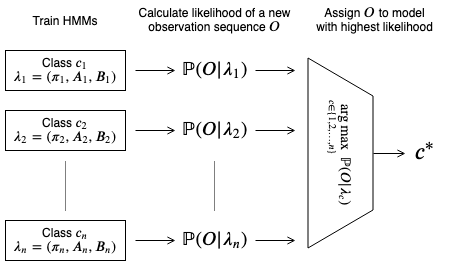A machine learning interface for isolated temporal sequence classification algorithms in Python.
Project description
A machine learning interface for isolated temporal sequence classification algorithms in Python.
Introduction
Temporal sequences are sequences of observations that occur over time. Changing patterns over time naturally provide many interesting opportunities and challenges for machine learning.
This library specifically aims to tackle classification problems for isolated temporal sequences by creating an interface to a number of classification algorithms.
Despite these types of sequences sounding very specific, you probably observe some of them on a regular basis!
Some examples of classification problems for isolated temporal sequences include classifying:
- isolated word utterances in speech audio signals,
- isolated hand-written characters according to their pen-tip trajectories,
- isolated hand or head gestures in a video or motion-capture recording.
Features
Sequentia offers the use of multivariate observation sequences with varying durations, in conjunction with the following algorithms and methods:
Classification algorithms
- Hidden Markov Models (via Pomegranate [1])
- Multivariate Gaussian Emissions
- Gaussian Mixture Model Emissions (soon!)
- Left-Right and Ergodic Topologies
- Approximate Dynamic Time Warping k-Nearest Neighbors (implemented with FastDTW [2])
- Long Short-Term Memory Networks (soon!)
Preprocessing methods
- Centering, standardization and min-max scaling
- Decimation and mean downsampling
- Mean and median filtering
Parallelization
- Multi-processing for DTW k-NN predictions
Disclaimer: The package currently remains largely untested and is still in its early stages – use with caution!
Installation
pip install sequentia
Documentation
Documentation for the package is available on Read The Docs.
Tutorials and examples
For tutorials and examples on the usage of Sequentia, look at the notebooks here.
References
Contributors
All contributions to this repository are greatly appreciated. Contribution guidelines can be found here.

Edwin Onuonga ✉️ 🌍 |
|---|
Sequentia © 2019-2020, Edwin Onuonga - Released under the MIT License.
Authored and maintained by Edwin Onuonga.
Project details
Release history Release notifications | RSS feed
Download files
Download the file for your platform. If you're not sure which to choose, learn more about installing packages.
Source Distribution
File details
Details for the file sequentia-0.7.0a1.tar.gz.
File metadata
- Download URL: sequentia-0.7.0a1.tar.gz
- Upload date:
- Size: 28.0 kB
- Tags: Source
- Uploaded using Trusted Publishing? No
- Uploaded via: twine/3.1.1 pkginfo/1.5.0.1 requests/2.22.0 setuptools/40.2.0 requests-toolbelt/0.9.1 tqdm/4.36.1 CPython/3.7.2
File hashes
| Algorithm | Hash digest | |
|---|---|---|
| SHA256 | ff35e0aee6af570fd8474356ff8262ddb2fc11156b97311fe44381fc9d2d360f |
|
| MD5 | b73046472f126ad0521afab0eb3142db |
|
| BLAKE2b-256 | 23d0826a2f8af073fa5aab948610c25a86dca08dbc553b5598963b1529e3d1ce |


















